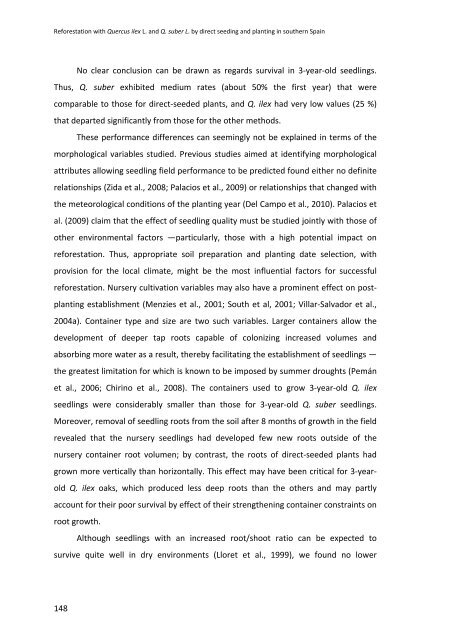Establecimiento de cuatro especies de Quercus en el sur de la ...
Establecimiento de cuatro especies de Quercus en el sur de la ...
Establecimiento de cuatro especies de Quercus en el sur de la ...
Create successful ePaper yourself
Turn your PDF publications into a flip-book with our unique Google optimized e-Paper software.
Reforestation with <strong>Quercus</strong> ilex L. and Q. suber L. by direct seeding and p<strong>la</strong>nting in southern Spain<br />
No clear conclusion can be drawn as regards <strong>sur</strong>vival in 3‐year‐old seedlings.<br />
Thus, Q. suber exhibited medium rates (about 50% the first year) that were<br />
comparable to those for direct‐see<strong>de</strong>d p<strong>la</strong>nts, and Q. ilex had very low values (25 %)<br />
that <strong>de</strong>parted significantly from those for the other methods.<br />
These performance differ<strong>en</strong>ces can seemingly not be exp<strong>la</strong>ined in terms of the<br />
morphological variables studied. Previous studies aimed at i<strong>de</strong>ntifying morphological<br />
attributes allowing seedling fi<strong>el</strong>d performance to be predicted found either no <strong>de</strong>finite<br />
r<strong>el</strong>ationships (Zida et al., 2008; Pa<strong>la</strong>cios et al., 2009) or r<strong>el</strong>ationships that changed with<br />
the meteorological conditions of the p<strong>la</strong>nting year (D<strong>el</strong> Campo et al., 2010). Pa<strong>la</strong>cios et<br />
al. (2009) c<strong>la</strong>im that the effect of seedling quality must be studied jointly with those of<br />
other <strong>en</strong>vironm<strong>en</strong>tal factors —particu<strong>la</strong>rly, those with a high pot<strong>en</strong>tial impact on<br />
reforestation. Thus, appropriate soil preparation and p<strong>la</strong>nting date s<strong>el</strong>ection, with<br />
provision for the local climate, might be the most influ<strong>en</strong>tial factors for successful<br />
reforestation. Nursery cultivation variables may also have a promin<strong>en</strong>t effect on postp<strong>la</strong>nting<br />
establishm<strong>en</strong>t (M<strong>en</strong>zies et al., 2001; South et al, 2001; Vil<strong>la</strong>r‐Salvador et al.,<br />
2004a). Container type and size are two such variables. Larger containers allow the<br />
<strong>de</strong>v<strong>el</strong>opm<strong>en</strong>t of <strong>de</strong>eper tap roots capable of colonizing increased volumes and<br />
absorbing more water as a result, thereby facilitating the establishm<strong>en</strong>t of seedlings —<br />
the greatest limitation for which is known to be imposed by summer droughts (Pemán<br />
et al., 2006; Chirino et al., 2008). The containers used to grow 3‐year‐old Q. ilex<br />
seedlings were consi<strong>de</strong>rably smaller than those for 3‐year‐old Q. suber seedlings.<br />
Moreover, removal of seedling roots from the soil after 8 months of growth in the fi<strong>el</strong>d<br />
revealed that the nursery seedlings had <strong>de</strong>v<strong>el</strong>oped few new roots outsi<strong>de</strong> of the<br />
nursery container root volum<strong>en</strong>; by contrast, the roots of direct‐see<strong>de</strong>d p<strong>la</strong>nts had<br />
grown more vertically than horizontally. This effect may have be<strong>en</strong> critical for 3‐yearold<br />
Q. ilex oaks, which produced less <strong>de</strong>ep roots than the others and may partly<br />
account for their poor <strong>sur</strong>vival by effect of their str<strong>en</strong>gth<strong>en</strong>ing container constraints on<br />
root growth.<br />
Although seedlings with an increased root/shoot ratio can be expected to<br />
<strong>sur</strong>vive quite w<strong>el</strong>l in dry <strong>en</strong>vironm<strong>en</strong>ts (Lloret et al., 1999), we found no lower<br />
148

















